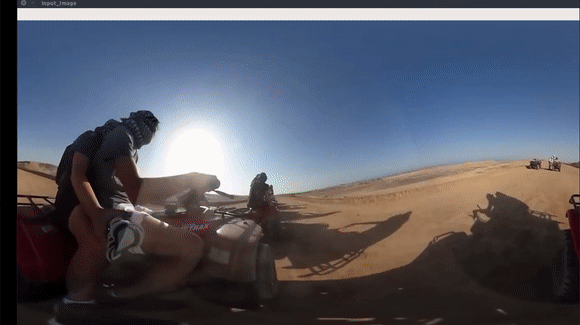GUI to control focus, distortion and view orientation to generate different kinds of distortion effects and get images with different properties¶
The software takes an equirectangular image/video frame and converts it into a new image based on the camera parameters, which can be controlled using the GUI. The python-based code was inspired by the official github repository.[2] for DeepCalib paper.[1] however, modifications were made in the code to improve real-time performance. The unified spherical model [3][4] is used to generate an output image.
contributions¶
Optimised NumPy operations to reduce computation time.
Remap function of OpenCV instead of interpolation to calculate the output image using the computed maps.
Storing the computed maps as object attributes and simply reusing them to avoid recomputing the maps. This shows a significant increase in the real-time performance of the software.
Average computation time for conversion for both methods has been tabulated for various output dimensions to explain the significant improvement in real-time performance of the code. Computation time for conversion by reusing the map stored as an object attribute is also given in the table.
Output image resolution |
code from deepcalib repository [2] |
Improved code (ours) |
Reusing the map (ours) |
|---|---|---|---|
1200x1200 |
1.059 s |
0.523 s |
0.149 s |
800x800 |
0.512 s |
0.276 s |
0.097 s |
500x500 |
0.247 s |
0.133 s |
0.067 s |
250x250 |
0.134 s |
0.073 s |
0.058 s |
The equirect2Fisheye() method of the library is used to develop the GUI. To learn how to use this method specifically refer to the example.
Usage Instructions¶
To open a video or image using the GUI run the following command:
python3 UCM_GUI.py <PATH TO THE FILE> <VIDEO_FLAG>
set <VIDEO_FLAG> = 1 if the file is a video file.
set <VIDEO_FLAG> = 0 if the file is an image file.
References¶
- [1] Bogdan, Oleksandr & Eckstein, Viktor & Rameau, François & Bazin, Jean-Charles. (2018).
DeepCalib: a deep learning approach for automatic intrinsic calibration of wide field-of-view cameras. 1-10. 10.1145/3278471.3278479.
[2] DeepCalib official repository -https://github.com/alexvbogdan/DeepCalib
[3] João P. Barreto. 2006. A Unifying Geometric Representation for Central Projection Systems. CVIU Volume 103, Issue 3, September 2006, Pages 208-217.
[4] C. Mei and P. Rives, “Single View Point Omnidirectional Camera Calibration from Planar Grids,” Proceedings 2007 IEEE International Conference on Robotics and Automation, Roma, 2007, pp. 3945-3950.
